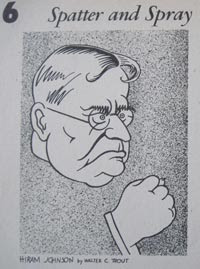
From this publication—
 I have several copies, found on the shelves the library provides for magazine donation/recycling/local house cleaning. This one is the oldest (1967); the others are from the early '70s.
I have several copies, found on the shelves the library provides for magazine donation/recycling/local house cleaning. This one is the oldest (1967); the others are from the early '70s.According to a collector, the magazine began as a family enterprise in 1935, with 16 newsprint pages of sewing and needlecraft patterns. By the late 1940s it had become successful enough to expand to a small magazine format. Bought by a larger company in 1990, the magazine folded six years later.
My '60s-'70s copies still are mostly newsprint; covers, plus a few interior illustrations and ads, are in color.
The magazine's long-time formula was a homey mix of recipes and needlework or other craft projects. Most of this went for the price of a subscription, or a single issue ($.25 to $.35 during this period), though some pages were devoted to sewing and other projects requiring readers to order patterns by mail.
Each month buyers got new patterns, like these good looks of the '70s—



Ads include lots of money-making schemes, both occupational and fund-raising.

A regular feature:

Not only could readers make $.25 to $1.00 a piece for these...
 ... but they also would earn $2 for a published submission (raised to $5 in the '70s).
... but they also would earn $2 for a published submission (raised to $5 in the '70s).Besides money-making opportunities, there were the usual women's magazine possibilities for self-improvement—even if companies and ads may have been a bit less slick than those in the pages of Good Housekeeping or McCall's—



Although there were some brand-name products also sold in stores, most items were mail order only, from companies that didn't seem to come with a Workbasket Seal of Approval.

While they would not exactly get their designers into MOMA...

...the products were made by small manufacturers located throughout the US. Ads for their wares crowded the pages of what, according to the collector's site above, had grown from its start in 1935, when—
The depression was in full swing, and Clara Tillotson's husband Jack had lost his job. Mrs. Tillotson used her resources and began putting together knitting, crocheting, tatting and quilting instructions. It was a time when people didn't have the money for new things; if they needed something, they made it. She sold patterns through the mail under the guise Aunt Martha's WORKBASKET; Home and Needlecraft for Pleasure and Profit.





































